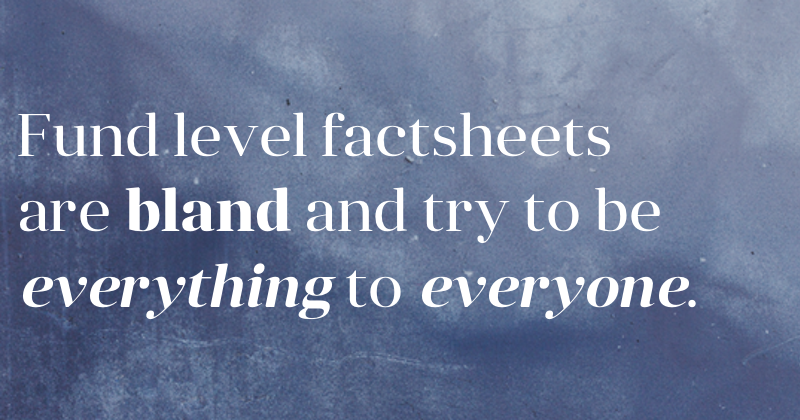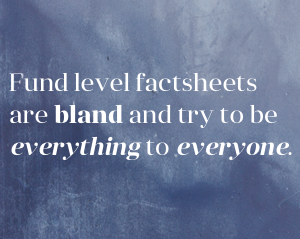A number of firms produce fund factsheets at “fund” level, rather than at the “share class” or “share series” level. The reasons for this tend to be historic and are often governed by the flexibility of the firms’ reporting systems, or perhaps the lack of reporting systems, hence the factsheet production maybe largely a manual process.

Producing fund factsheets at fund level, generally means there’s less of them to produce, as one factsheet would cover multiple share classes. Thus, where the reporting system is inflexible, or unscalable or perhaps non-existent, it is easier for an investment firm to produce a smaller number of factsheets.
However, are these factsheets really up to the job?
The short answer is, no. Fund level factsheets don’t really suffice and here’s why:
- Fund level factsheets are bland and try to be everything to everyone. However, can the investor tell which share class he or she is invested in from the factsheet provided? No. The factsheet typically would contain details of all the shareclasses, the different fees, perhaps it contains multiple performance returns, or maybe a single “representative” share class return. Is that the return the investor received – difficult to tell if the factsheet isn’t share series specific.
- Fund level factsheets contain a lot of information about all the various shareclasses on offer. As well as being potentially confusing (see the point above) it also uses up more of the space available on the page, and therefore leaves less room for more pertinent and relevant information or content.
- KIIDs (Key Investor Information Documents) have to be produced at shareclass level. It would make most sense that the factsheet is produced at the same level of granularity as the KIID document so that direct comparisons can be made between the two documents.
- Automated distribution – completed and up to date factsheets need to be sent all around the world, to various fund platforms, to websites, to individual investors, so that the investors are provided with up to date and relevant information about their investments. This process can be simply undertaken where the document can be machine read and automatically distributed accordingly to a set of rules. This is quite a straight-forward process for shareclass level factsheets. However, where fund level factsheets are produced and distributed (this distribution may even need to be manual), how can the computer or website decide which factsheet to display to the investor if the investor is selecting a specific share class and the only document available to the website is at fund level?
The reporting trend we see within the industry is a move towards greater levels of reporting personalisation. This is manifesting itself in a variety of ways. The fund level fund factsheet seems to be a long way from any level of customer personalisation, and any firms still producing fund factsheets at that level should consider a review of their legacy practice.

